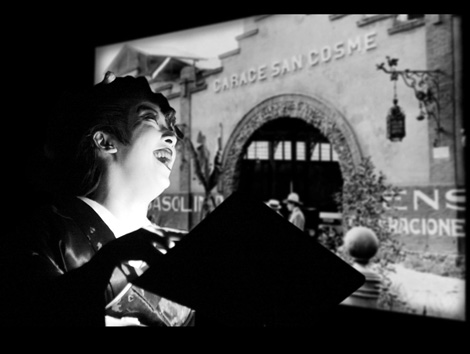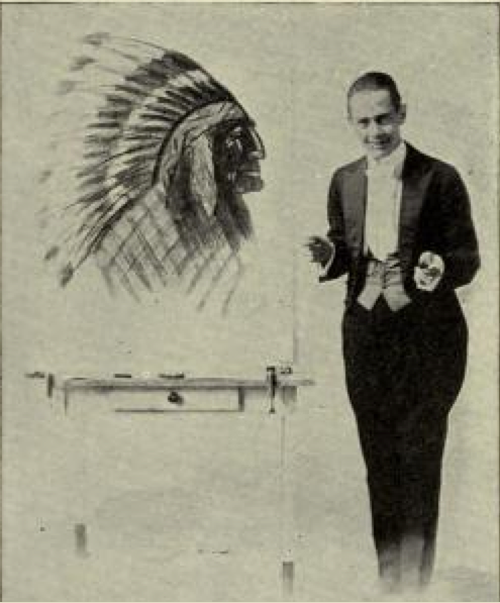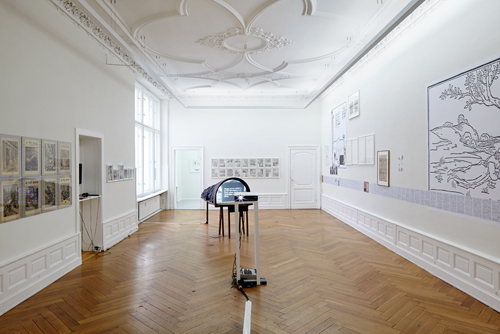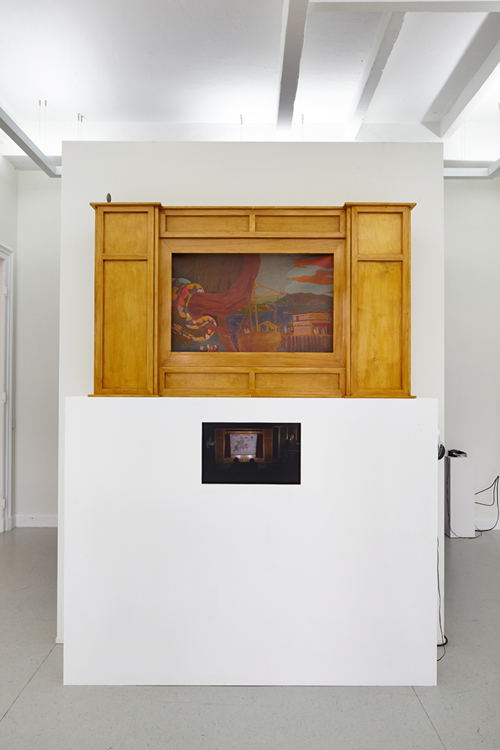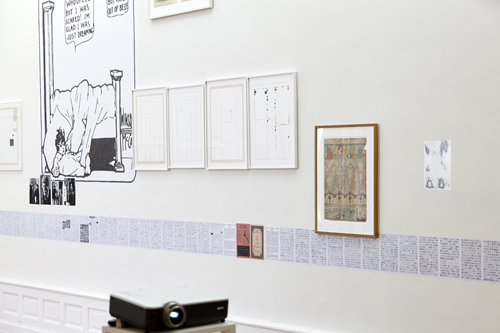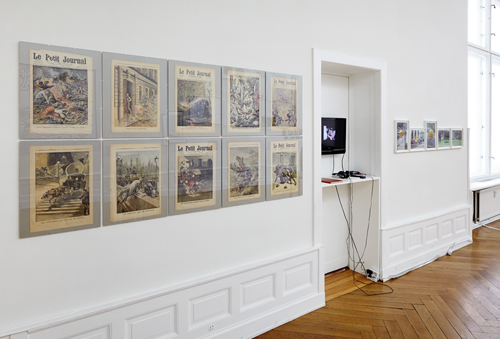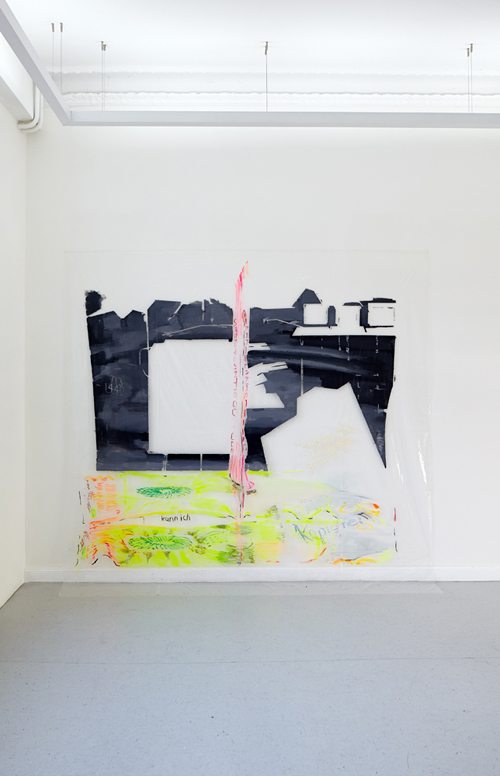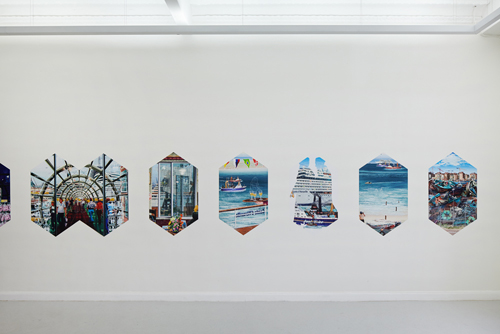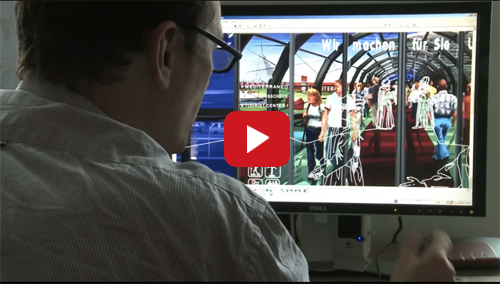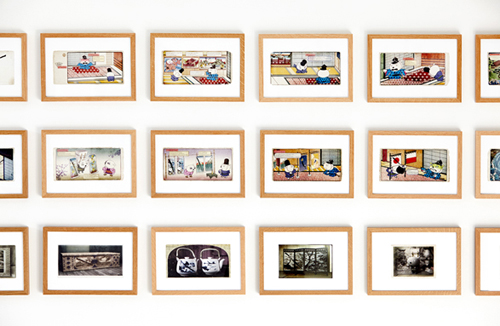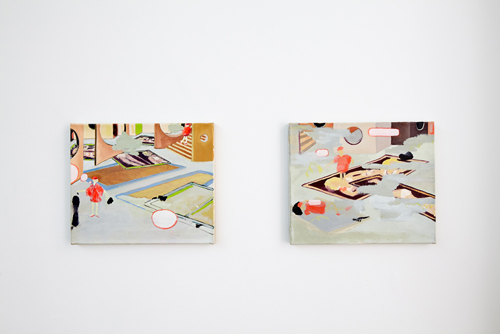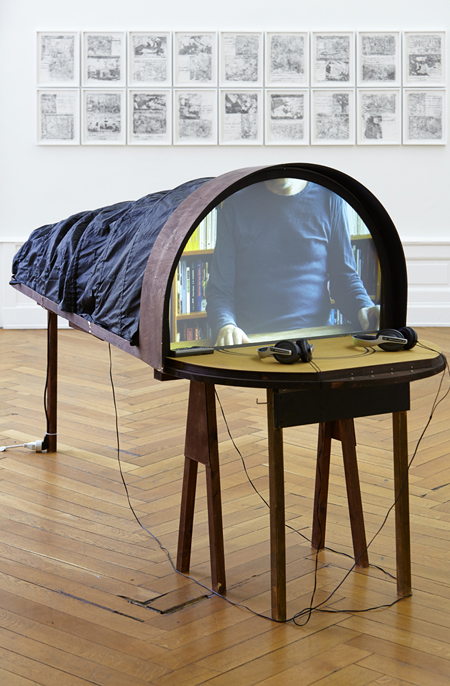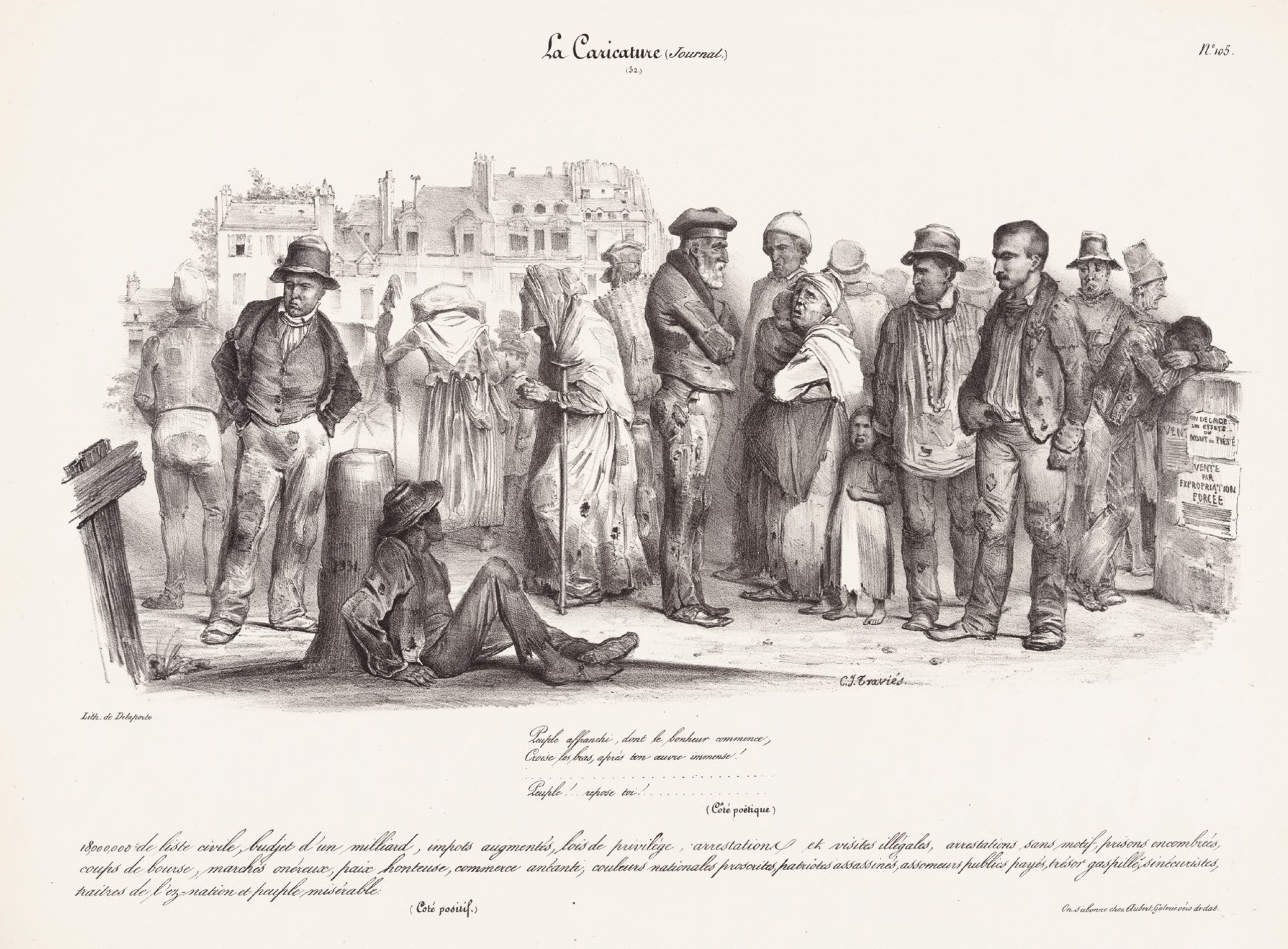Clemens Krümmel]
[December 20, 2013
TALKING PICTURE BLUES (including an interview with Andreas Siekmann)
An exhibition from the Melton Prior Institute for Reportage Drawing and Printing Culture in Düsseldorf, organized by Clemens Krümmel for Kunstsaele Berlin, Bülowstraße 90, D-10783 Berlin, November 1, 2013 – January 11, 2014
Included is an interview with Andreas Siekmann on his picture cycle “Die Exklusive. Zur Politik des ausgeschlossenen Vierten” (A film by Clemens Krümmel, camera: Romana Schmalisch)
Talking pictures – this expression relates to artistic image concepts and practices connected with frequent implications that pictures are in fact able to speak or talk. Or it has been insinuate that artists’ pictures have to talk – to speak for themselves, as it were – or otherwise they would have to be considered either “bad art” or no art at all. “If my pictures don’t speak for themselves, that means I have failed as an artist” – phrases such as this one are heard in art contexts at least since the inception of modernity, when artists refer to the autonomous character of their works. Still, speaking out next to pictures has a great history – and this does not only include street balladeers or market criers. For a long time, practices of the text-image, of text-based documentary art forms, of description and recitation, have not only developed in the direct context of artworks, but also as hybrid artistic modes of production in their own respective rights.
Benshi, a Japanese film narrator
A vaudeville chalk talk-performance
Coming from the context of the Melton Prior Institute this exhibition presents an arrangement of various pictures and works. In one part, these exhibits are confronted and combined with each other in a freely structured collage, in another they are embedded in a variety of theatrical forms as individually curated collecting devices for a number of image-historical themes. As can be considered typical for public appearances of the Melton Prior Institute – this presentation also reaches back to the beginning of the Industrial Revolution and artistic modernity, in order to question contemporary productions whose conventions seem generally accepted against a historical backdrop. In a montage-style setup, the perspective this time relates to certain traditions around the production and mediation of images and has implicit and explicit ties to today’s ubiquitous screen presentations. Within a cabinet framework, works and pictures from this century-old field of reference are juxtaposed, who would probably also be perceived as “art” without verbal, textual or performative assistance. But either there is a heightened awareness of rhetorical imagw qualities to be sensed in the selected works developed mostly out of a competition with photography and film. Or there is a literal layer of comment or explanation involved in these works – as a filmed documentation or a live performance, for instance. Such comments, but also recitations, descriptions, fantasies can be experienced here not only within the competitive framework of the supposedly autonomous type of artistic images or pictures, but also as a mode of co-production.
Talking Picture Blues, Installation view, hall 1
In collaged wall arrangements, but also in documentary recordings of performances, the exhibition attempts an evocation of a special, partially displaced tradition of “speaking next to pictures”. The earliest pictorial allusions in the exhibition go back to the early modern era, the western threshold of the Renaissance. With a scale model of the Grand Moving Mirror of California, part of the presentations of the Velaslavasay Panorama based in Los Angeles, a picture recitation theatre reconstructed from a description of the mid-19th century is a major exhibit in this show – referencing the early times of the picture industries, in this case a reconstruction from the cultural context of American Vaudeville theatres which anticipated the history of popular moving images for a mass audience with scroll paintings presented by a picture reciter. While the picture scroll is being moved to pass by in front of the spectators, the reciter describes the history of California with exaggerated intonation, gesture and facial expression.
The Grand Moving Mirror of California – reduced model of the picture recitation theatre in Los Angeles (www.panoramaonview.org).
Another protagonist of the Vaudeville era was Winsor McCay, cartoonist and pioneer of the drawn animation film – not only did he create some of the first longer drawn and animated features, he also presented them himself, with classical “showmanship,” in the movie theaters of amusement parks. His central role for the topic of this exhibition is also highlighted by a choice of original newspaper pages (from the collection of Alexander Braun in Bonn) taken from his immensely successful comics series “Little Nemo in Slumberland” whose image design breathtakingly predates rhetorical devices of the movies, stretching and liquefying the cohesive quality of pictures to the extreme, making pictures objects of serialization, inversion and anamorphotic treatments. The grown expectations projected upon the mass image (but also on artistic perception in general) in competition with photography and film are shown through European examples from the collections of the Melton Prior Institute: The cover designs of illustrated newspapers published in colors around the turn of the last century, such as Le Petit Journal in France, may best exemplify the incredible energies that artistic imagination and resourcefulness brought to the fore facing the possibilities of “automatic” technical picture productions: in what was the technological state of the art back then, they still held the monopoly of a “purified” mode of seeing that was capable to construct the still image of the “frozen moment”.
Albrecht Schäfer, Cuttings, courtesy Gallery Joanna Kamm, Berlin; 2 Sunday supplements by Winsor McCay, Coll. Alexander Braun, Bonn; “Longshot Comics” by Shane Simmons, “Wall Piece” (2013) von Karin Sander
Le Petit Journal, Museum of American Art, Alice Creischer
This is where another thread materializes: After the disappearance of the picture reciter (and film narrator), printed picture reproductions, but also individual artistic images, are set into an increasingly dynamized, rhetorical framing system – which can be observed in the dynamization and distortion of comics page panels, as it is prominently the case with Winsor McCay’s works. This is a thesis implicitly proposed in the exhibition: Modern page design in books and illustrated newspapers takes over part of the reciters’ animating duties (and of course runs parallel to filmic modes of pictorial thinking). In this sense, a number of “cut-up” pictures by artist Albrecht Schäfer bridge the gap to contemporary views – in which print space, type space and page layout increasingly subside and dematerialize. His framed newspaper pages are but extremely fragile framing constructions from which the artist has removed all picture and type parts with a scalpel. What remains in each case is the surface with its linear rhythm of now empty spaces of disposition, a residue of modernism.
René Magritte, “L’homme au journal”, 1928 – art print, 21 x 30 cm
Dierk Schmidt’s typically self-reflexive painting projects, which in many different ways have their point of departure in an ongoing inquiry into the possibility of a contemporary history image (as opposed to history painting), have over the last decade led to the creation and presentation of a unique array of picture-rhetorical methods and devices of critique. His contribution to this exhibition parallelizes and confronts not only the modes of appearance that pertain to the economies in contemporary artistic practices, he also formulates “speaking” picture complexes, which, in this instance, pose specific questions to their original context, and which, with their fragile materiality, address processes of valorization inside the art market.
Dierk Schmidt, “Warum hab ich Schulden gemacht?”, 1996 Öl. Acryl, tape on plastic sheet, 302 x 294 cm (Courtesy Gallery Ursula Walbröl, Düsseldorf)
Alice Creischer, artist and curator, has, from the beginning of her artistic activities, placed great emphasis on the production of artistic and critical texts. Around the end of the 1980s she constructed a kind of giant roller mechanism for use in her text performances. The roll she pushed in front of herself was equipped with all the texts she would then recite in an ambulant fashion.
Over the last ten years, Andreas Siekmann has become a well-known creator of great picture cycles – which are created on the computer, but certainly not with those professional image processing tools that are in use these days, but through the “creative abuse” of a nigh-ancient function within the world’s most frequently used text software, “Word”, originally only intended for pushing around some icons and ornaments in your text files. Siekmann has appropriated these means in a unique way. For his 96-part cycle “The Exclusive” (recently presented in its entirety as part of an exhibition at the Museum Ludwig in Cologne), loosely based on Dante’s narrative of the circles of hell in his “Divine Comedy,” he has used “Word” for insanely multi-layered and complex picture creations culled from the global humdrum news reality of those zones of exclusion that are drastically intensifying recently. The density of pictorial information represents an important point of attraction in this series – but what if… the artist could be heard commenting his own pictures, in such a way that the wealth of factual information folded into them does no longer remain a mere premonition, but invades reality through the other channel of spoken language?
Andreas Siekmann, “Cruise, from the picture cycle “Die Exklusive. Zur Politik des ausgeschlossenen Vierten”, 2001-2013, Courtesy Gallery Barbara Weiss, Berlin
An interview with Andreas Siekmann on his picture cycle “Die Exklusive” , by Clemens Krümmel (camera: Romana Schmalisch)
(click on the image to play)
The painter, draughtsman, filmmaker and composer Stefan Ettlinger has recently begun to work on a very idiosyncratic series of graphic works, from which a sizeable excerpt is presented as part of “Talking Picture Blues”. His paintings and drawings typically consist of elements combined out of several different picture sources whose transitions can oftentimes only be intuited. But also seen as a whole, his work is marked by an extraordinary fluidity, an extremely refined sense for the “open spots” in an image appropriated (mostly as screenshots from television and digital video) and the resulting (or self-erasing) sites of transition. Those parts which Ettlinger in his paintings generally merges on the pictorial level with great virtuosity, are here, in this graphite tracings, countered on a textual level by word elements written out in clumsified pre-school handwriting, forming lines and paragraphs in which the last part of each individual word merges with the fist part of the following to create a new and spurious moment of meaning. From Ettlinger’s point of view, pictures and images are always already fusion products, they just need to be acknowledged as such – thus proposing a very basic notion of the image, an idea of pictorial narration which has its roots at that threshold between the personally mediated and the technical image which marks the conceptual core of this exhibition.
Stefan Ettlinger, Stefan Hayn
In his narrative series “Hinomaru – Sky Full of Horizons”, graphic designer and artist Felix Reidenbach presents his take on the intercultural reversal of perspective thinking which unto this day keeps fascinating imageologists: The pictural logic of ancient Japan from which a “flat” distribution of image spaces has sprung. Employing those typical figures that he has developed for his early comics works (published as “die niedlichen” – the ”cute ones”, serialized in the 1990s as part of the then Cologne-based music magazine Spex), Reidenbach unfolds a story of the censorship on a “wrong” perspective that has happened, but has happened the other way round. With its fictitious reversal of perspective presented in this 18-part series of prints there is also an aspect of rhetorical, indexical reference to pictures and images – which are taken here as representative for a certain fashion of perspectival depiction, but also allude to diverse global systems of perception and systems of power enactment.
Felix Reidenbach, “Hinomaru – Himmel voller Horizonte” (Detail), January 2011, Epson K3 Fine Art Print on Hahnemühle Photo Rag, www.dieniedlichen.de
Viola Rusche, “Ohne Titel”, 1994, Courtesy Gallery Ursula Walbröl, Düsseldorf
The empty center of a great collage-style wall in the Salon is the place of Karin Sander’s “wall piece” – a rectangular portion of the painted wall gradually and painstakingly hand-polished and densified to become an oily, gleaming, reflective surface – represents the point blank of imaginations of the flat, the superficial. Around this point, enlarged photocopies, pinned posters and art prints, framed newspaper pages, graphic prints and drawings represent a great variety of depths inside and outside the pictorial plane. The relations between the different frame formats and levels of comment are of some importance here. The actual space of the Salon is further extended into the depth dimension by using the moveable wall element dividing both exhibition halls for the makeshift construction of a small stage space which will be used for the projection of the animated video “Lost Buildings,” produced by one of today’s most interesting illustrators and cartoonists, Chris Ware, in collaboration with Ira Glass.
Winsor McCay, Karin Sander
A small adjacent cabinet space houses two films by Berlin-based filmmaker and painter Stefan Hayn – “Malerei heute” (“Painting today”) is a seemingly neutral report about a project of Hayn the painter, in the course of which he produced watercolors of billboard posters in Berlin’s public spaces and subway stations, before or after his daytime work, over an extended period of several years. The long-term character of his experiment allows for unusual and certainly not only factual insights into the changing zeitgeist in the 1990s’ (formerly) “public spaces.” Along with the video screening of this originally filmic work, several of the original watercolors presented are exhibited. The second, shorter contribution “Ein Film über den Arbeiter” (“A film about the worker”), follows a similar logic of committed, subjective reportage by highlighting the increasingly difficult consequences of a de-solidarized working life through multiple political, artistic and personal threads of narrative. There will be drawings accompanying this film as well, pictures that were instrumental in the emotional development during the preparatory stages of this film, but were also serving narrative functions within it.
Stefan Hayn, Projections of two films (“Malerei heute” , 1998-2005, 61 Min., und “Ein Film über den Arbeiter”, 1997, 18 Min.) © Stefan Hayn filmproduction – to the left and to the right watercolours and drawings from both films
The “Mobile Cinema” organized by artist Romana Schmalisch, is a mobile structure allowing the use as a public screening device, working with a video projector directed to the back of a semi-circular screen. This cinema has been transported to different places throughout Europe with different screening programs; the physical ”presence” still plays an important role here, especially because and although mostly absent persons are presented in the screenings. This cinema strongly references filmic practices of the historical Russian avant-gardes, both content-wise and regarding the peculiar, half-cone shape of this presentation apparatus.
Romana Schmalisch, “Mobile Cinema”, 2009 ff. ( Programm a.o..: 1. Views of Remote Countries / A Visual Archive (6:22), Romana Schmalisch, Mixed Media, 2009, Text: Esther Buss – 2. The Sinking of the Lusitania (12:07), Winsor McCay, 1918 – 3. Entwurf (8:47) Romana Schmalisch, HD, 2013 nach Aufzeichnungen von Sergei Eisenstein – 4. Resurrecting Spectres and Vampires (27:52), Robert Schlicht, DV, 2009 5. DIE VORSTELLUNG DES FILMS (17:00) Romana Schmalisch, HD, 2013, Zitate aus Sergei Eisensteins Aufzeichnungen und Entwürfen für den geplanten Film „Glashaus“, 1926–1930 – 6. FILMERZÄHLER, BENSHI, SEKUNDÄRE KUNST (10:44) HD, 2013, Text: Clemens Krümmel, Stefan Ettlinger, “Ohne Titel”, 2013 – 18 Graphit-Tracings on paper, 29,7 x 21,0 cm
all images: Jan Brockhaus
